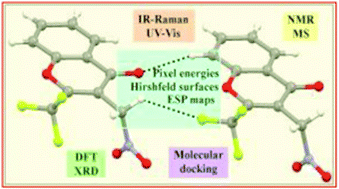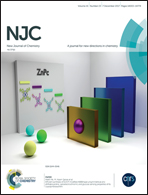The role of non-covalent interactions in some 2-trifluoromethylchromones in the solid state†
Abstract
The intermolecular interactions in the solid state and the spectroscopic vibrational, electronic and NMR properties of new 3-methyl-substituted-2-trifluoromethylchromone derivatives with –CN (1), –NO2 (2), –OH (3) and –NH2 (4) groups were discussed with the assistance of DFT calculations. The crystal structures of compounds 1–3 were determined by X-ray diffraction showing molecular ribbons for compounds 1 and 2, and dimers via O–H⋯O![[double bond, length as m-dash]](https://www.rsc.org/images/entities/char_e001.gif) C hydrogen bonds for 3. Hirshfeld surfaces and the corresponding fingerprint plots, as well as the electrostatic potentials mapped on the surfaces revealed C–H⋯O and C–H⋯F hydrogen bonds, and π⋯π stacking as the main cooperative driving forces for building supramolecular architectures in all compounds. The C–H⋯π and C
C hydrogen bonds for 3. Hirshfeld surfaces and the corresponding fingerprint plots, as well as the electrostatic potentials mapped on the surfaces revealed C–H⋯O and C–H⋯F hydrogen bonds, and π⋯π stacking as the main cooperative driving forces for building supramolecular architectures in all compounds. The C–H⋯π and C![[double bond, length as m-dash]](https://www.rsc.org/images/entities/char_e001.gif) O⋯π interactions also contribute to stabilizing the crystal structures of 1 and 2. A further analysis of Hirshfeld surfaces was performed using the enrichment ratio as a new descriptor to determine the likelihood of chemical species to establish specific interactions in the molecular packing. The lattice energies of the crystal structures and several intermolecular contacts present in different molecular pairs were also quantified. Molecular docking studies showed the interaction of the title compounds with the catalytic site of PLA2 (PDB code 2QOG) from Crotalus durissus terrificus, and suggested that the investigated compounds could inhibit toxic effects of snake venom.
O⋯π interactions also contribute to stabilizing the crystal structures of 1 and 2. A further analysis of Hirshfeld surfaces was performed using the enrichment ratio as a new descriptor to determine the likelihood of chemical species to establish specific interactions in the molecular packing. The lattice energies of the crystal structures and several intermolecular contacts present in different molecular pairs were also quantified. Molecular docking studies showed the interaction of the title compounds with the catalytic site of PLA2 (PDB code 2QOG) from Crotalus durissus terrificus, and suggested that the investigated compounds could inhibit toxic effects of snake venom.



 Please wait while we load your content...
Please wait while we load your content...